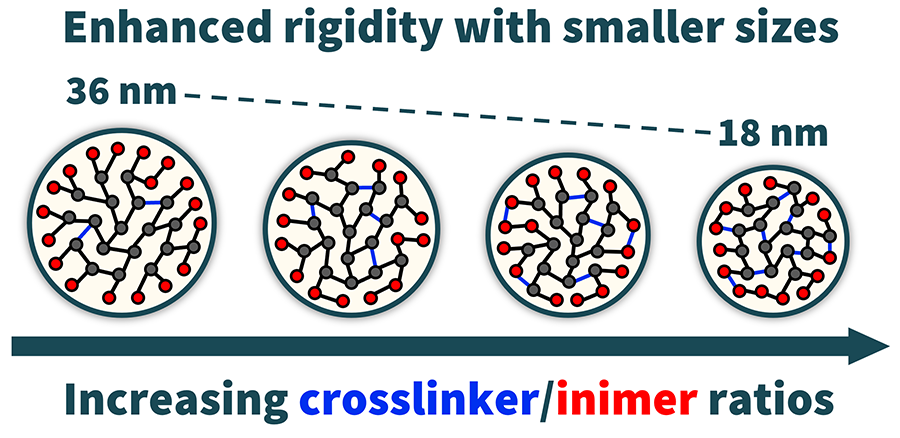Collaborating with the University of Houston and the Max Planck Institute for Polymer Research, scientists have explored ways to enhance these materials by grafting polymers onto nanoparticles. This approach, detailed in the Proceedings of the National Academy of Sciences, unlocks new potential for diverse applications.
 Tunable size achieved through varying cross-linker/inimer compositions. Image Credit: Proceedings of the National Academy of Sciences.
Tunable size achieved through varying cross-linker/inimer compositions. Image Credit: Proceedings of the National Academy of Sciences.
Nanoparticles, prized for their small size and customizable properties, are revolutionizing fields from electronics to medicine.
Although existing materials were limited in terms of their mechanical properties and chemical tunability, organic nanoparticles (oNP) are more chemically versatile than their inorganic counterparts, allowing for functionalization and customization to suit specific biomedical and technological applications.
A recent investigation into the effects of chemical cross-linking and hyperbranching of oNP—a process by which the two combined mechanisms produce a dense bonding network.
The research, led by Carnegie Mellon faculty Krzysztof Matyjaszewski of the Chemistry Department and Michael Bockstaller of the Department of Materials Science and Engineering, demonstrates the ability to control both functional attributes and elastic properties. This innovative "bottom-up" approach is well-suited for creating functional materials across a wide range of applications.
In cooperation with scientists at the University of Houston and the Max Planck Institute for Polymer Research in Germany, the work, which was funded by the Department of Energy's Office for Basic Energy Sciences, advances our understanding of the fundamental variables that govern the characteristics of organic nanoparticles (oNPs) and the chemical processes that make them possible to synthesis.
Through the combination of these processes, we have been able to demonstrate the capabilities of organic nanoparticles to exhibit inorganic-type stiffness.
Michael R. Bockstaller, Department of Materials Science and Engineering, Carnegie Mellon University
First-Author Rongguan Yin, a Doctoral Student in Chemistry, developed a novel and precise method for synthesizing functional nanoparticles using atom transfer radical polymerization (ATRP), which allowed for an advanced level of control over the structure and properties of oNPs.
The designed and precisely prepared by ATRP functionalized organic nanoparticles are, in fact, new gigantic single macromolecules of the molar mass reaching values of 100 million Daltons.
Krzysztof Matyjaszewski, Faculty, Department of Chemistry, Carnegie Mellon University
The new oNP system's macroinitiator properties, which allow for flexible graft modification, are a key component. By direct assembly or integration, the resultant brush-tethered oNPs open up novel applications in a variety of nanomaterial technologies.
The incorporation of functionalities outlined in this work opens the door for organic nanoparticles to further improve optical properties in materials.
Michael R. Bockstaller, Department of Materials Science and Engineering, Carnegie Mellon University
Building on this work, future studies in the groups of Bockstaller and Matyjaszewski will investigate functionalization prospects like fluorescence for this novel class of oNPs and assess their efficacy in real-world applications.
Jirameth Tarnsangpradit, a Doctorate Candidate in Materials Science and Engineering, Jaepil Jeong, a Graduate of Chemistry, Xiaolei Hu, a Doctorate Candidate in Chemistry, Yuqi Zhao, a Doctorate Graduate in Materials Science and Engineering, and Hanshu Wu, a Doctorate Candidate in Chemistry, are additional Carnegie Mellon contributors to this research.
Journal Reference:
Yin, R., et al. (2024) Organic nanoparticles with tunable size and rigidity by hyperbranching and cross-linking using microemulsion ATRP. PNAS. doi.org/10.1073/pnas.2406337121